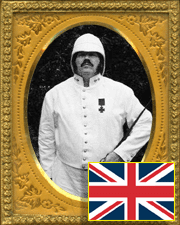

Chuck Kamps
 |
 |
| Her Britannic
Majesty’s Envoy Extraordinary to The United States of America
Chuck Kamps |
Colonel Sir Harry Flashman, V.C., K.C.B.
Flashman, Harry Paget. Born 5 May 1822 Ashby, Leicestershire, to Capt. Harry Buckley Flashman, M.P., late 23rd Light Dragoons, and the Honourable Alicia Paget. Educated Rugby School. Commissioned 1839, 11th Light Dragoons [11th Prince Albert’s Own Hussars]. Married 1840 to Elspeth Rennie Morrison, daughter of the late Lord Paisley. Honourable East India Company [H.E.I.C.] service 1840-42 as Aide-de-Camp [A.D.C.] to General Officer Commanding Army of the Indus; Acting Commandant, Piper’s Fort; Defense of Jellalabad, Queen’s Medal for Afghanistan. Inspector of Remounts, H.E.I.C., Singapore 1843. Royal Navy Batang Lupar Expedition 1844 as Chief of Staff to the Rajah of Sarawak. Chief Drill Instructor, Malagasy Army 1844-45. First Sikh War 1845-46: H.E.I.C. Political Service at the Court of Lahore; A.D.C. to Commander-in-Chief Army in India; Ferozeshah, Sobraon. Crimean War: Inspector of Small Arms Tests, Board of Ordnance 1854; Colonel on the Staff [gazetted to 17th Lancers] and A.D.C. to General Officer Commanding Army of the East, Crimea 1854; Alma, Balaclava. Prisoner of War, Russia 1855. Operations with Central Asian partisans 1855; Fort Raim. Indian Mutiny: Political Service 1856-57; Chief of Intelligence to General Havelock’s Column 1857; Meerut, Cawnpore, Lucknow, Jhansi, Gwalior; Victoria Cross, Knight Commander of the Most Honourable Order of the Bath. Second China War 1860: Political Service, representative to Taiping Rebels; Chief of Intelligence, British China Force; Taku Forts, Peking. Appointed A.D.C. to H.R.H. The Prince of Wales, Curragh Camp, Ireland 1861. Appointed Envoy Extraordinary to the United States of America 1861. Club: White’s. Residences: Berkeley Square, London; Gandamack Lodge, Ashby, Leicestershire.In the photograph, Colonel Flashman is wearing a cavalry hot weather undress uniform, consisting of a shell jacket and trousers of white cotton duck, and the 1845 pattern tropical helmet as modified after the Sepoy Mutiny. This was common dress for parades, drills, and mess in hot climates although, by this time, khaki, or the traditional scarlet, would be worn on campaign, depending on the climate. The decoration worn is the Victoria Cross